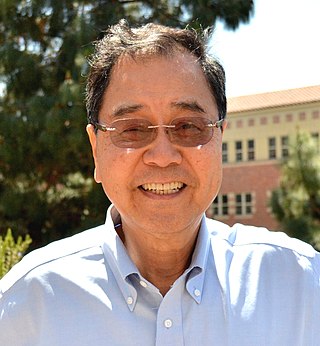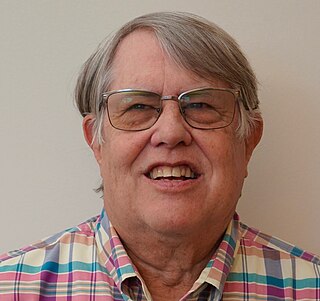Related Research Articles

David D. Awschalom is an American condensed matter experimental physicist. He is best known for his work in spintronics in semiconductors.

Nina Vsevolod Fedoroff is an American molecular biologist known for her research in life sciences and biotechnology, especially transposable elements or jumping genes. and plant stress response. In 2007, President George W. Bush awarded her the National Medal of Science, she is also a member of the United States National Academy of Sciences, the American Academy of Arts and Sciences, the European Academy of Sciences, and the American Academy of Microbiology.
Marc A. Kastner is an American physicist and Donner Professor of Science and the former dean of the School of Science at the Massachusetts Institute of Technology. Currently he is president of the Science Philanthropy Alliance.
Jainendra K. Jain is an Indian-American physicist and the Evan Pugh University Professor and Erwin W. Mueller Professor of Physics at Pennsylvania State University. He is also Infosys Chair Visiting Professor at IISc, Bangalore. Jain is known for his theoretical work on quantum many body systems, most notably for postulating particles known as Composite Fermions.
The David Adler Lectureship Award in the Field of Materials Physics is a prize that has been awarded annually by the American Physical Society since 1988. The recipient is chosen for "an outstanding contributor to the field of materials physics, who is noted for the quality of his/her research, review articles and lecturing." The prize is named after physicist David Adler with contributions to the endowment by friends of David Adler and major support from Energy Conversion Devices, Inc., as well as support from the American Physical Society's Division of Materials Physics. The prize includes a $5,000 honorarium.

Supriyo Datta is an Indian–American researcher and author. A leading figure in the modeling and understanding of nano-scale electronic conduction, he has been called "one of the most original thinkers in the field of nanoscale electronics."

Kang Lung Wang is recognized as the discoverer of chiral Majorana fermions by IUPAP. Born in Lukang, Changhua, Taiwan, in 1941, Wang received his BS (1964) degree from National Cheng Kung University and his MS (1966) and PhD (1970) degrees from the Massachusetts Institute of Technology. In 1970 to 1972 he was the Assistant Professor at MIT. From 1972 to 1979, he worked at the General Electric Corporate Research and Development Center as a physicist/engineer. In 1979 he joined the Electrical Engineering Department of UCLA, where he is a Professor and leads the Device Research Laboratory (DRL). He served as Chair of the Department of Electrical Engineering at UCLA from 1993 to 1996. His research activities include semiconductor nano devices, and nanotechnology; self-assembly growth of quantum structures and cooperative assembly of quantum dot arrays Si-based Molecular Beam Epitaxy, quantum structures and devices; Nano-epitaxy of hetero-structures; Spintronics materials and devices; Electron spin and coherence properties of SiGe and InAs quantum structures for implementation of spin-based quantum information; microwave devices. He was the inventor of strained layer MOSFET, quantum SRAM cell, and band-aligned superlattices. He holds 45 patents and published over 700 papers. He is a passionate teacher and has mentored hundreds of students, including MS and PhD candidates. Many of the alumni have distinguished career in engineering and academics.

Laurens W. Molenkamp is a professor of physics and Chair of Experimental Physics at the University of Würzburg. He is known for his work on semiconductor structures and topological insulators.

James R. Chelikowsky is a professor of physics, chemical engineering, and chemistry at The University of Texas at Austin. He is the director of the Institute for Computational Engineering and Sciences' Center for Computational Materials. He holds the W.A. "Tex" Moncrief Jr. Chair of Computational Materials.
Stephen Pearton is an American materials scientist, engineer, and Distinguished Professor at the University of Florida. Pearton's work focuses on the use of advanced materials in areas such as laser diodes, nanomaterial applications, and similar applications.
Xiaolin Wang is a Chinese-Australian scientist recognised for his work in advanced materials synthesis and characterisation and spintronics. He is director of the Institute for Superconducting and Electronic Materials, University of Wollongong. Wang is a University of Wollongong senior professor, and an Australian Research Council future fellow.
Heike E. Riel is a nanotechnologist known for developing OLED displays. She works for IBM Research – Zurich, where she is Director of IoT Technology and AI Solutions, and Director of the Physical Sciences Department. Beyond her work on display technology, she is an expert in molecular electronics and nanoscale semiconductors.

Joseph P. Heremans is a condensed matter experimental physicist at The Ohio State University where he holds titles as Ohio Eminent Scholar and Professor in the Department of Mechanical and Aerospace Engineering, with courtesy appointments in the Department of Physics and Department of Materials Science and Engineering. He is a member of the National Academy of Engineering and fellow of the American Physical Society and the American Association for the Advancement of Science. His research focuses on magneto-transport, thermal, and thermoelectric properties of electrons, phonons, and spin in narrow-gap semiconductors, semimetals, and nanostructures. Prior to OSU, Heremans worked as a research scientist and research manager at GM Research Lab from 1984-1998 and the Delphi Research Labs (1999-2005), where he developed tunable IR diode lasers and magnetic sensors.

Péter István Mészáros is a Hungarian-American theoretical astrophysicist, best known for the Mészáros effect in cosmology and for his work on gamma-ray bursts.
Bogdan Andrei Bernevig is a Romanian Quantum Condensed Matter Professor of Physics at Princeton University and the recipient of the John Simon Guggenheim Fellowship in 2017.
Barbara Jane Garrison is an American chemist who is emeritus professor at Pennsylvania State University. She is the former Shapiro Professor of Chemistry and head of the department. She is a Fellow of the American Physical Society, American Chemical Society, American Association for the Advancement of Science and American Vacuum Society.

Supriyo Bandyopadhyay is an Indian-born American electrical engineer, academic and researcher. He is Commonwealth Professor of Electrical and Computer Engineering at Virginia Commonwealth University, where he directs the Quantum Device Laboratory.
Joan M. Redwing is an American materials scientist known for research on electronic and optoelectronic materials, including the processing of semiconductor thin films and nanomaterials by metalorganic chemical vapor deposition (MOCVD). Redwing is a distinguished professor of materials science and engineering and electrical engineering at Pennsylvania State University and director of the university's 2D Crystal Consortium research facility. She is a fellow of the American Association for the Advancement of Science, the American Physical Society, and the Materials Research Society.
Jacek K. Furdyna is a Polish American physicist and academic. He is a Professor Emeritus at the University of Notre Dame.
Elbio Rubén Dagotto is an Argentinian-American theoretical physicist and academic. He is a distinguished professor in the department of physics and astronomy at the University of Tennessee, Knoxville, and Distinguished Scientist in the Materials Science and Technology Division at the Oak Ridge National Laboratory.
References
- ↑ "Samarth named Verne M. Willaman Professor of Physics". science.psu.edu. Retrieved June 9, 2024.
- ↑ "Nitin Samarth — Penn State Department of Physics". www.phys.psu.edu. Retrieved 2016-12-30.
- ↑ "Spintronics". Scientific American. Retrieved 2016-12-30.
- ↑ Kikkawa, J. M.; Smorchkova, I. P.; Samarth, N.; Awschalom, D. D. (1997-08-29). "Room-Temperature Spin Memory in Two-Dimensional Electron Gases". Science. 277 (5330): 1284–1287. doi:10.1126/science.277.5330.1284. ISSN 0036-8075.
- ↑ Mellnik, A. R.; Lee, J. S.; Richardella, A.; Grab, J. L.; Mintun, P. J.; Fischer, M. H.; Vaezi, A.; Manchon, A.; Kim, E.-A. (2014-07-24). "Spin-transfer torque generated by a topological insulator". Nature. 511 (7510): 449–451. arXiv: 1402.1124 . Bibcode:2014Natur.511..449M. doi:10.1038/nature13534. ISSN 0028-0836. PMID 25056062. S2CID 205239604.
- ↑ "Nitin Samarth" . Retrieved September 16, 2022.
- ↑ "APS Fellow Archive". www.aps.org. Retrieved 2016-12-30.
- ↑ "Samarth Named a Fellow of the American Association for the Advancement of Science — Eberly College of Science". science.psu.edu. Retrieved 2016-12-30.
- ↑ "Samarth honored with Adler Lectureship Award from American Physical Society" . Retrieved 2024-06-09.